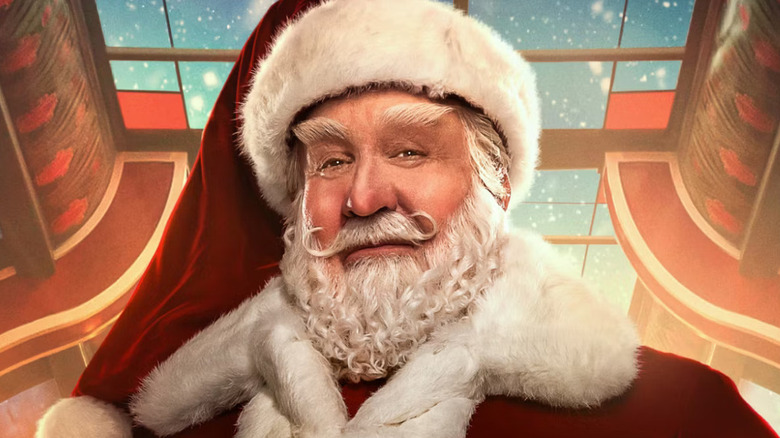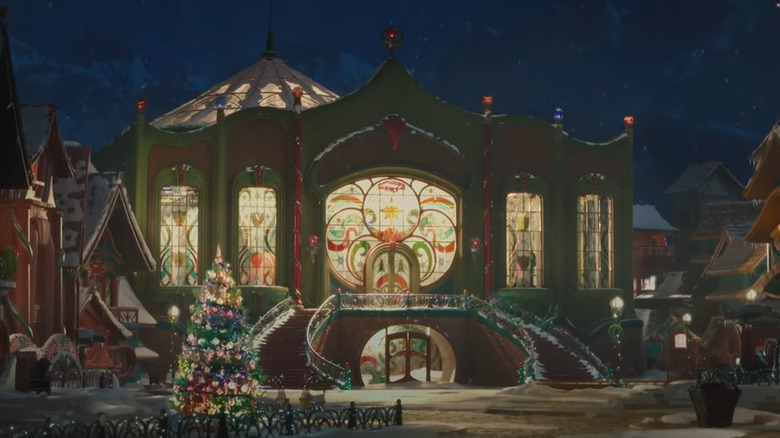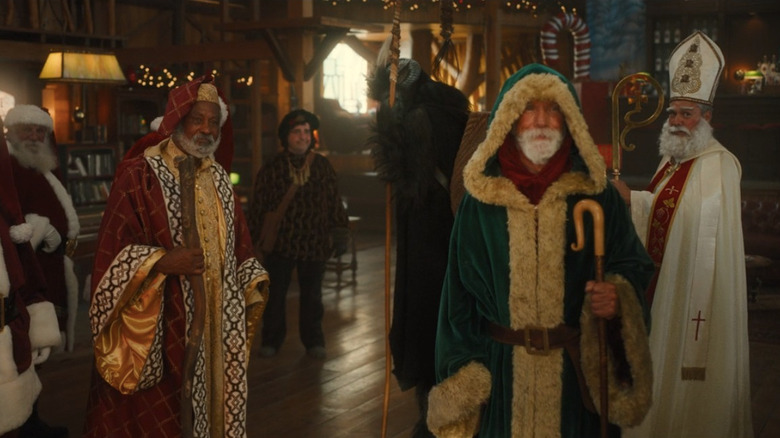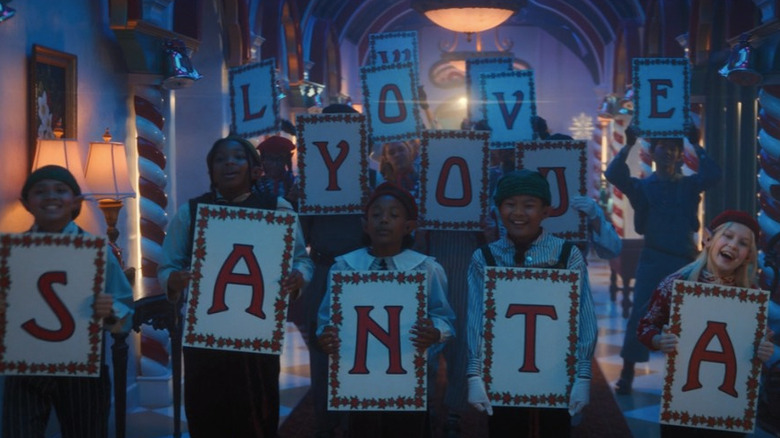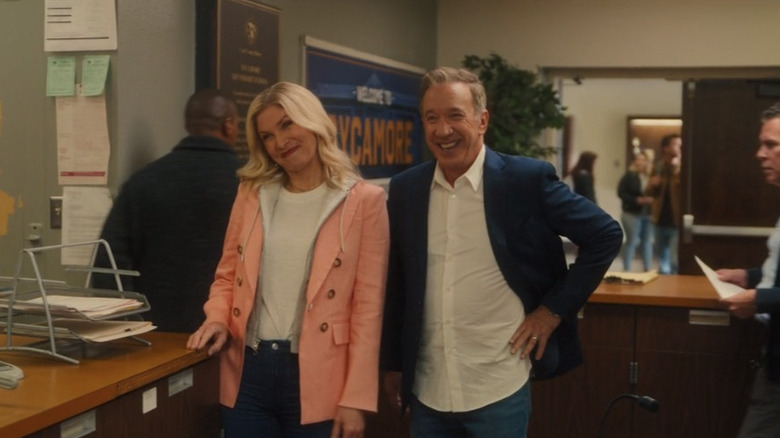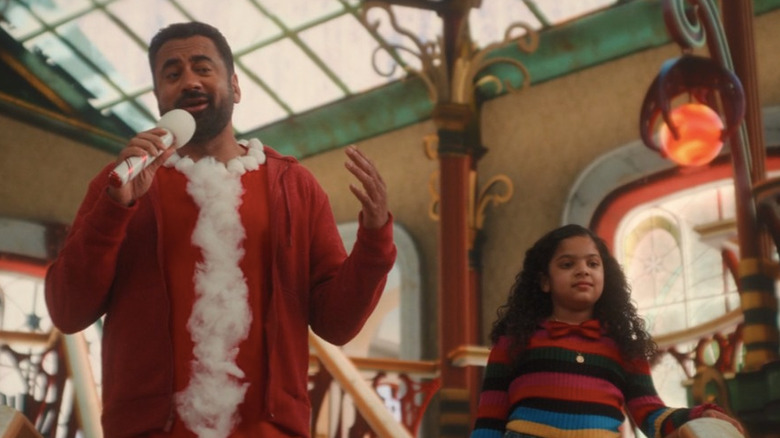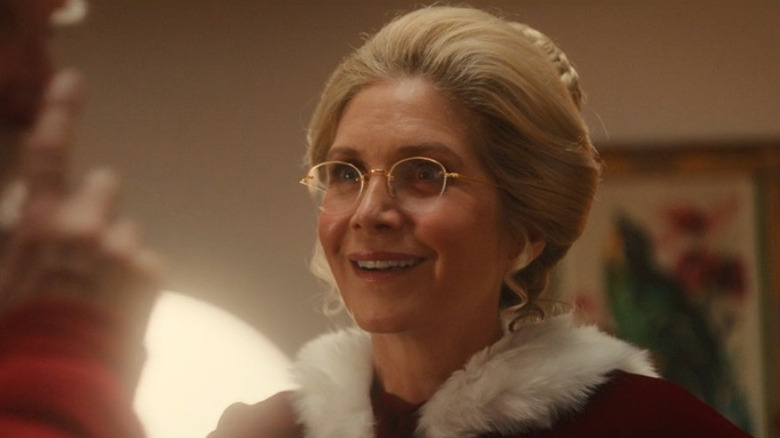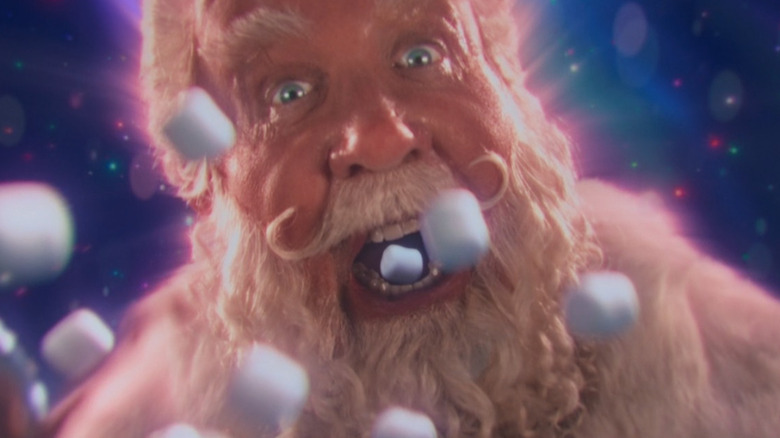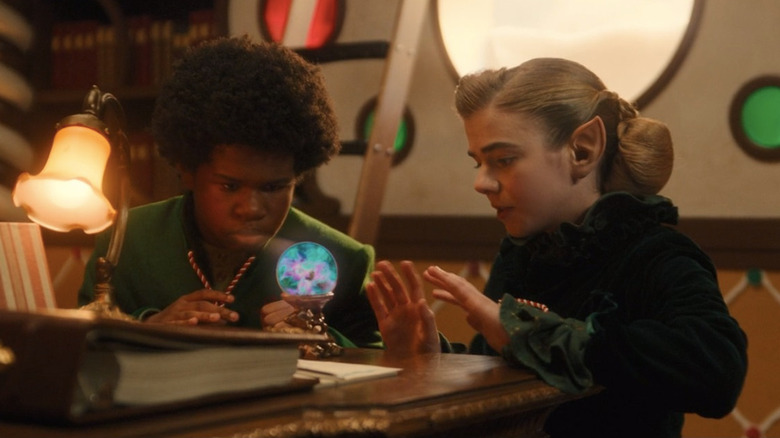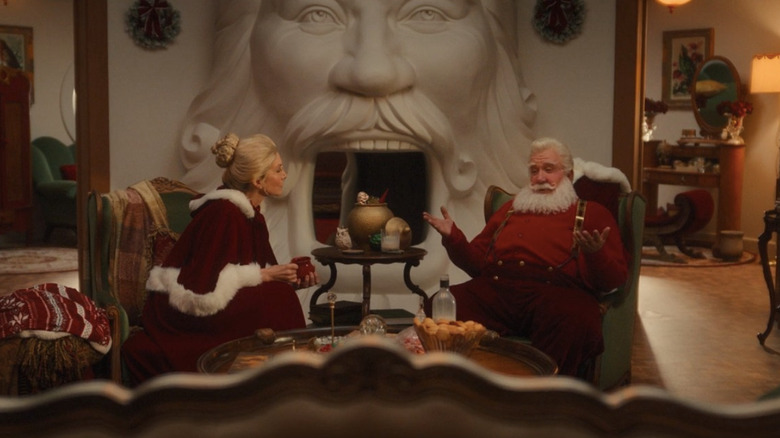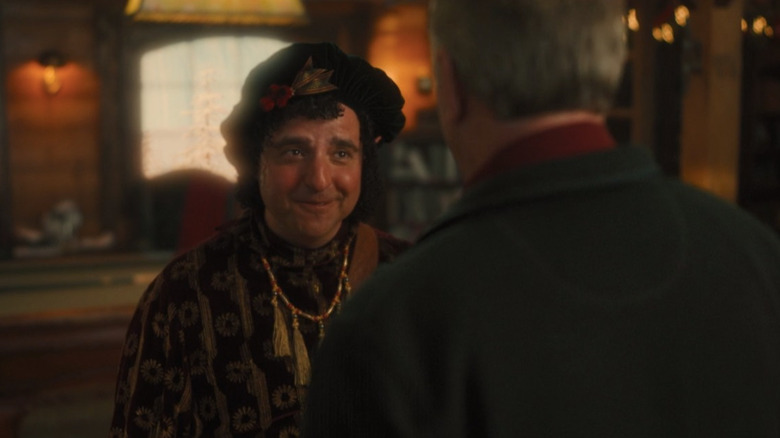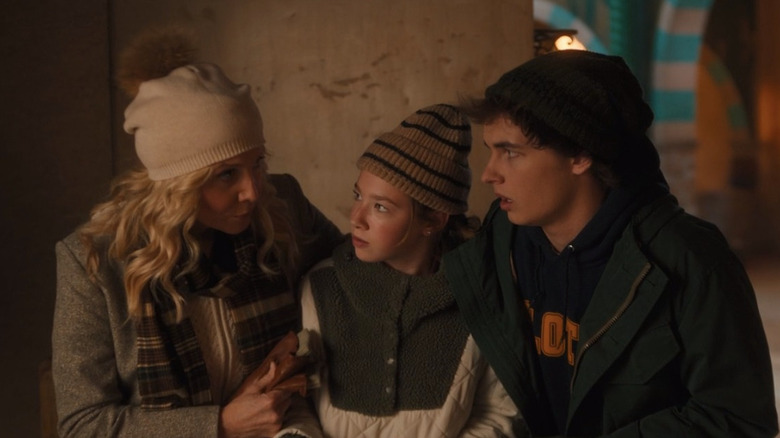The 6 Best And 6 Worst Things In The Santa Clauses
This article contains spoilers for "The Santa Clauses."
Tim Allen is back in the saddle (or is it back in the sleigh?) in "The Santa Clauses," the 2022 Disney+ miniseries that serves as a sequel of sorts to the "Santa Clause" trilogy. Almost 30 years after Allen first donned Santa's iconic red outfit, he and a handful of original cast members join a collection of newcomers to tell the next chapter in this family-favorite holiday tale.
A lot has happened since we last saw the Calvin family in 2006's "The Santa Clause 3: The Escape Clause." The infant born in that film is now a teenager, Cal, and he's got a little sister, Sandra. Santa's inner circle of top elves is almost entirely new. And Santa himself, after three decades, is considering retiring from his gig, noticing that his magic is starting to wane. The modern streaming era — known for franchise projects and actors returning to play their signature roles in legacy sequels — would feel incomplete without Allen portraying Santa again, even if it's just one last time.
In the series' leap from the big screen to television, there's a lot "The Santa Clauses" gets right. However, it's far from perfect. These are the best and worst things about the show.
Best: It has something to say
Many reboots rely exclusively on nostalgia to fuel their stories. While "The Santa Clauses" includes a few familiar faces, the script seems to be careful to only bring an established character back into the fold if their inclusion makes sense to the story. This is a refreshing change of pace from other legacy sequels that throw every single half-recognizable character back into the mix, even if their presence stretches the believability of the narrative.
Furthermore, the story of "The Santa Clauses" could have played it safe by rehashing past adventures. It comes as a pleasant surprise that the series instead seeks to expand the franchise into new territory, with Santa facing the facts of his age, searching for a replacement, and pondering the many philosophical themes that come with that scenario. The series takes an introspective look at Santa's retirement, something Tim Allen was intent on getting right if he was going to return to the role.
Speaking to The Hollywood Reporter in November 2022, Allen said, "As I get older in my performance career, it's all about words on paper. When streaming increased the demand for content, I knew it was coming, so I said, 'Show me some words.' It took a long time to get to that communication." He went on to say that after filming the series, he was happy with the result. "The reason it's good is because we worked our a** off to make this funny and wonderful for the audience. That's the only reason we did it."
Worst: Bad CGI
A noticeable difference between "The Santa Clauses" and the films is that much of the North Pole is computer-generated now — though thankfully not all of it. Actor Kal Penn (who plays Simon, a new character) told Collider: "A lot of people think the set must have been green screen, or something like that. No, it was a practical set. And then, a lot of it was a Volume Stage, so it was a 180-degree screen that turned as we would turn." The Volume is a next-generation evolution of greenscreen technology in which LED lights allow the actors to see the environments they're pretending to inhabit.
While in some productions the Volume can be pretty convincing, for "The Santa Clauses," most of its use is noticeable, especially when the very same environments were fully built out in previous films. The difference between the main courtyard area of the North Pole — formerly a huge set and now a computer rendering — is particularly glaring. The reindeer are also CGI, a huge step down from their charming mechanical counterparts in the movies. When something from nearly three decades ago looks better than the production value of a modern project, it's rather distracting.
Best: It considers multicultural Santa traditions
Tim Allen's Santa Claus is a dead ringer for the version of Santa popularized in American culture, but what about the various Santas familiar to kids in other countries? In a franchise first, "The Santa Clauses" includes other versions of Santa known around the world and from history, like Papai Noel and Saint Nicholas. According to the story, those versions aren't all Santa at the same time as Scott Calvin; they've all been the Santa for the entire world at different points in history. "The Santa Clauses" doesn't just stop at different versions of Santa, either.
Also Included in the show is La Befana, the traditional witch from Italy's holiday season. "While in most other parts of the world, Christmas and New Year holidays have now come to an end, Italians are still celebrating, as every January 6, the Epiphany, is a national holiday to commemorate the visit of the Three Kings, 'i Re Magi,' to the Baby Jesus," explains Italy Magazine. "This is also the day when children receive presents from La Befana, a legendary figure who flies on a broomstick on Epiphany Eve and comes down the chimney to fill children's socks with either candy and presents, if they have been good, or a lump of coal if they have been naughty." La Befana isn't a Santa-like figure in the show as she is to Italian children in real life, but her presence deepens the show's holiday lore and helps make the Santa-verse feel more inclusive.
Worst: The songs feel forced
Those who were kids in the 2000s might remember the absolute festive treats that were "Santa Claus Lane," Hilary Duff's song that accompanied the end credits of "The Santa Clause 2," and "The Greatest Time of Year," Aly & AJ's upbeat tune that performed the same function for "The Santa Clause 3: The Escape Clause." We can only assume that there was some kind of mandate to include catchy songs in "The Santa Clauses," because there are two musical moments within the series that feel extremely forced.
In the first episode, the elves celebrate a successful Christmas Eve by singing a cover of "Girls Just Wanna Have Fun" entitled "Elves Just Wanna Have Fun." Later in the series, as the elves prepare for Scott Calvin's retirement, they perform a cover of "Last Christmas" that is essentially a Kidz Bop number. Maybe these songs will become just as beloved as the Hilary Duff and Aly & AJ tunes of yesteryear, but don't count on it.
Best: It explains plot holes
There were a lot of unanswered questions from the trilogy of "Santa Clause" films, both about the plot (like, "Is the former Santa really dead?") and the general lore of the world (like, "Why does Mrs. Claus not have a first name?"). Filling in those gaps and clarifying parts of the story that were never fully explained was part of what convinced Tim Allen to do the show in the first place, as the actor explained during an appearance on "The Tonight Show."
Allen told host Jimmy Fallon: "I never understood, even in the movie, why the elves, when I showed up to the North Pole, didn't go, 'Hey, what happened to the other guy?' I just hop in the sleigh with the kid and we go off. Nobody ever asks. Does Mrs. Claus know that the other guy's dead? Did the other guy die? There's huge holes." The new series does its best to tie up loose ends, and, even though it creates a few new questions in the process (like, "Did Bernard continually check in with the past Santas?"), it does a generally good job of this.
Worst: It should have been a movie
"The Santa Clauses" runs for six episodes. When their run times are added together, without credits, it comes in at 171 minutes. If you trimmed the fat, there's no reason that this couldn't have been a feature-length film. One can't help but wonder if the series would have done better as "The Santa Clause 4." It basically reads as one long story anyway, rather than employing episodic segments. The main issue is that the show struggles to translate the grandeur of the franchise to the small screen.
The Hollywood Reporter's interview with Tim Allen suggests that the decision for the project to be a series could have been driven more by budget than anything else. "I don't know anything about the streaming thing other than the fact that creatively it's literally a hybrid of doing a multicamera TV show and a movie," the actor said. "I know for a fact ["The Santa Clauses"] isn't costing them what a movie costs."
Would "The Santa Clauses" have worked better as a movie rather than as a series? Probably. That also could have increased its shelf life. Is a family more likely to add a six-episode series to their annual holiday watchlist, or a movie? Probably the latter.
Best: Elizabeth Mitchell
One of the best things about "The Santa Clauses" is having Elizabeth Mitchell back as Carol Newman-Calvin, aka Mrs. Claus. Mitchell entered the "Santa Clause" franchise in 2002's "The Santa Clause 2," and she has since become known for such roles as Dr. Juliet Burke in "Lost" and Ingrid the Snow Queen in "Once Upon a Time." In contrast to Scott's more difficult time getting acclimated to life in the real world, Carol is delighted and almost instantly finds her groove. She dives back into her career in school administration, the field that first connected her with Scott when she was Charlie's principal during his rebellious teenage phase.
Mitchell — who told Entertainment Tonight that she'd be thrilled to portray Carol again back in 2019 before the spinoff was a reality — is clearly having a lot of fun being back in this universe, and she elevates every scene she's part of. In her quest to discover the origins of Mrs. Claus, Carol, unfortunately, doesn't get any clarity, but she clears her own path and creates her own template. Mitchell brings that arc to life wonderfully, reminding us that she's a great actor.
Worst: The bizarre intro sequence
Since "The Santa Clauses" is a series rather than a movie, it includes a brief intro sequence at the beginning of every episode. It's not quite a theme song, but more of a 14-second, holiday-themed psychedelic trip. With the Northern Lights as a backdrop and a choir of operatic voices singing in a somewhat spooky tone, the camera shows extreme close-ups of a reindeer, an elf, and Santa in various stages of whimsy and/or distress. All the while, hot chocolate ingredients go flying past their faces in slow-motion. We get very close to Santa's mouth as a marshmallow tumbles toward it.
The intro concludes with the Calvin family in a snowglobe, smiling and posing like it was a '90s sitcom. Dozens of Santa figurines fall around them and a refrain of "Jingle Bells" fills the air. The entire bit is... a choice. The nonsensical direction might have felt at home in a show that was a bit more zany, but it doesn't really match anything about "The Santa Clauses." It feels jarring every time it appears rather than teeing up the episode to follow, and it's particularly grinding when you're binge-watching, with its weirdness becoming a distraction.
Best: The new head elves
There are several new supporting characters in "The Santa Clauses," including a new roster of elves at the North Pole. Matilda Lawler — who viewers may recognize from "Station Eleven" on HBO Max and "Flora & Ulysses" on Disney+ — is excellent as Betty, Santa's chief of staff. Betty's no-nonsense approach to protocols paired with her unending love of Christmas makes her a perfect foil for her husband Noel. A good friend of Santa, Noel is played by Devin Bright of "The Unicorn" on CBS. He's a bit more relaxed and spontaneous than Betty.
All of Santa's elves are hundreds of years old, but they are portrayed by child actors. Lawler and Bright embody their tenured characters as if they really have been doing this for centuries. It's not until deep into the series when the stakes begin to rise that they really show their maturity. When the new characters' futures are jeopardized, we as viewers become suddenly aware of the attachment we've formed with them over the course of the series, and that's a testament to the performances.
Worst: The cringe factor
Topical jokes and pop-culture references aren't always bad. Sometimes they can add a layer of wit to the script in question, even when overt. Things feel a bit more muddled when a script tries to wink at the audience with a timely reference, but the audience doesn't know if the bit is supposed to make them laugh or if it's a political statement. Such is the case with "The Santa Clauses," which contains quite a few gags that feel out of place.
In one scene, Santa laments that "saying 'Merry Christmas to all' has become problematic," which comes across as a little mean spirited and doesn't exactly align with the show's use of festive figures from different cultures. It was described as a "lightning rod" statement by Deadline. Elsewhere, Santa mentions "Christmas deniers," which may or may not be a play on COVID deniers, and if so doesn't even make sense in its context. By the time an elf mentions NFTs ("nutty fudge teacakes," of course), viewers will have sore eyes from all the rolling.
Surprisingly, it could have been even worse. Series creator Jack Burditt told Deadline that an early version of one scene included someone shooting at Santa's sleigh. "And Noel the elf says something like, 'A war on Christmas!'" Burditt said. "I'm like, yeah, I don't wanna go that far."
Best: The return of Bernard
David Krumholtz returns in "The Santa Clauses" as Santa's former head elf Bernard to show Scott the history of the Santa lineage. Krumholtz's appearance is especially notable considering he backed out of his role in "The Santa Clause 3," which never addresses the character's absence. Finally, after all this time, the audience learns that Bernard didn't even give Santa an explanation for leaving.
It turns out that Bernard went on an elf Rumspringa and simply never returned sometime between the events of the second and third films. Bernard reunites with Santa in present day and tells him he married Oscar-winner Vanessa Redgrave. By choosing to live in the real world, Bernard started aging, explaining why he no longer has his youthful elf looks.
The character's inclusion in "The Santa Clauses" is significant enough to not feel like a throw-away cameo, and it speaks to the series' goal of wrapping up the story. It would have been easy to throw in several former characters from the iconic trilogy (especially since the franchise boasts quite a few star names, like Judge Reinhold and Martin Short), but the writers managed to resist, and Bernard's appearance was more meaningful as a result.
Somewhat strangely, though, in the same way that Bernard's absence was never addressed in "The Santa Clause 3," Bernard's replacement as head elf in that movie (Spencer Breslin's Curtis) is similarly absent without explanation in "The Santa Clauses."
Worst: The release date
Disney+ (and streaming at large) has a consistently stacked menu. In the same week that "The Santa Clauses" debuted its first episodes in November 2022, Disney+ also dropped the highly anticipated sequel to "Enchanted," a full-length documentary about the history of Mickey Mouse, and the penultimate episode of "Andor" Season 1. Any one of these projects alone would be a big deal. When they all release within three days of each other, how much attention can a show like "The Santa Clauses" really expect to get?
That's a crowded landscape, and that's only on one streaming service. The same week, HBO Max premiered "A Christmas Story Christmas," and Apple TV+ debuted "Spirited," both of which were poised to be their respective streamer's big holiday releases. With so many choices, both within the festive genre and in general, the "The Santa Clauses" always had its work cut out for it. Of course, being a show about Santa, it had to release around the holidays, but if Disney had just held off that little bit longer, "The Santa Clauses" might have stood more chance of making an impact.
